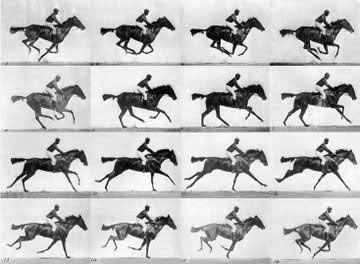Eadweard J. Muybridge ( 9 April 1830 – 8 May 1904) was an English photographer who spent much of his life in the United States. He is known for his pioneering work on animal locomotion which used multiple cameras to capture motion, and his zoopraxiscope, a device for projecting motion pictures that pre-dated the flexible perforated film strip.
Galloping horse set to motion using photos by Eadweard Muybridge.
Stanford and the galloping question
Main article: Sallie Gardner at a Gallop
Muybridge's The Horse in Motion.
In 1872, former Governor of California Leland Stanford, a businessman and race-horse owner, had taken a position on a popularly-debated question of the day: whether all four of a horse's hooves are off the ground at the same time during the trot. Up until this time, most paintings of horses at full gallop showed the front legs extended forward and the hind legs extended to the rear.[9] Stanford sided with this assertion, called "unsupported transit", and took it upon himself to prove it scientifically. Stanford sought out Muybridge and hired him to settle the question.[10]
In later studies Muybridge used a series of large cameras that used glass plates placed in a line, each one being triggered by a thread as the horse passed. Later a clockwork device was used. The images were copied in the form of silhouettes onto a disc and viewed in a machine called a Zoopraxiscope. This in fact became an intermediate stage towards motion pictures or cinematography.
In 1877, Muybridge settled Stanford's question with a single photographic negative showing Stanford's Standardbred trotting horse Occident airborne at the trot. This negative was lost, but it survives through woodcuts made at the time. By 1878, spurred on by Stanford to expand the experiment, Muybridge had successfully photographed a horse in fast motion.[11]
Another series of photos taken at the Palo Alto Stock Farm in Stanford, California, is called Sallie Gardner at a Gallop or The Horse in Motion, and shows that the hooves do all leave the ground — although not with the legs fully extended forward and back, as contemporary illustrators tended to imagine, but rather at the moment when all the hooves are tucked under the horse as it switches from "pulling" with the front legs to "pushing" with the back legs.[10] This series of photos stands as one of the earliest forms of videography.
(From Wikipedia)
I have always been interested in animal locomotion and last year searched for the above photos by Muybridge .
I wanted to make a fairly technical gif (that is now on some disc I'm too lazy to search for at the moment) with several externals and the horse running through it. First I had to chop the above series of plates in order to remove the background and rider. My avatar is the the result of that first stage of the final gif.
The finished gif actually ended up with two horses running across a field and I was pretty impressed with myself when it was finished.
But what really impresses me now, is how privileged I felt, to take a very important piece of photographic history through over 130 years of photographic evolution.
I have a love of old glass plate negatives and to think of the work involved by Muybridge to obtain these images and the subsequent digital process that I later applied to them... I wonder if he could have ever imagined a world of photography minus stumbling around in the darkness, inhaling noxious chemicals and devoid of even film itself.
Don't get me wrong, I always enjoyed working in the darkroom and the modern photographer who never has, is missing out on a very creative and unique part of the photographic process. But it's also nice to be able to chop in the living room while watching "My Name is Earl".
But what must have took Muybridge many hard hours of trial and error, with trip wires, a multitude of large format cameras and who knows what else, we can now accomplish in the fraction of time with modern equipment. To me, and maybe to you as well... it's all absolutely amazing.

There's some quote about how all we accomplish and can see from today's viewpoint, is only because we are privileged to stand on the shoulders of those who came and labored so hard before us. Photography is a very good example of that sentiment.
If anyone has some old images from glass plates or any other interesting photographic history comments, please post them here if you like.





